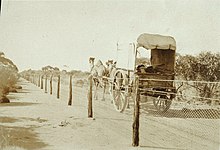Rabbit-Proof Fence
The Rabbit-Proof Fence ( English for 'rabbit -proof fence'), actually State Barrier Fence of Western Australia and nowadays better known as The Vermin Fence , was a protective fence in Western Australia , mainly to prevent rabbits (but also other animals) from doing so to spread on the pasture and arable land there or to introduce diseases. It was built between 1901 and 1908 and consisted of three partial fences with a total length of 3,256 km. The cost was 337,841 pounds Sterling .
background

Rabbits were introduced in 1788 with the First Fleet , the fleet that brought the first settlers to Australia, and were initially kept in stables. However, in 1859 a farmer in Victoria released 24 rabbits, believing that a few rabbits would do no harm and that hunting rabbits would make him feel more at home.
In 1891 the rabbits had almost completely colonized the continent through mass reproduction and were also spotted for the first time in Western Australia. In 1896 an officer was sent out to check how far the rabbits had gotten into the state. He spotted rabbits on the coast at Esperance , some 320 km west of the South Australian border and less than 100 km east of Jerdacuttup , and recommended the construction of a fence along the South Australian border in his report. In 1901 a royal commission decided to build this fence from the south to the north coast.
The fence
The originally planned fence crossed the state from Jerdacuttup in the south to Wallal in the north and had a length of about 1,837 km. As "Rabbit-Proof Fence No. 1 ”and the longest fence in the world, he became known. Construction began in December 1901 and ended in September 1907. But as early as 1902 rabbits were spotted again west of the fence and two more fences were planned.
Fence No. 2 and 3 was started in 1905 in Bremer Bay in the south of the country, about 100 km west of Jerdacuttup. At a length of around 1166 km, it initially ran north, at a distance of around 150 km from the west coast at Perth and then made a wide bend towards the first fence at about Kalbarri Met near Murchinson . Fence No. 3 was also built in 1905. Fence No. 3 began in Kalbarri, roughly in the middle of the Australian west coast, and ran in an easterly direction for a length of around 253 km almost directly towards fence No. 2.
Effects
Ultimately, the first fence was never a safe protection against the intrusion of animals. In places the wood of the posts became rotten, the fence corroded or the gates in the fence were simply left open so that animals could repeatedly enter. Especially during the First World War, farmers in Western Australia suffered from a veritable plague of rabbits. They built their own fences around their property, used poison, hired hunters or tried to destroy rabbit burrows and tunnels with tractors. Even schoolchildren earned their pocket money by hunting rabbits. Only in the most south-westerly area of Western Australia, which was surrounded by fences 2 and 3, has the population been kept at a tolerable level since the 1920s.
For this purpose, "rabbit inspectors" were used for control purposes, who inspected the fence with the Australian camel , mainly in the north, or a camel cart, in the south, and kept an eye out for rabbits. Camels had already proven to be the best mode of transport when the fence was being built, as they were persistent and could do without water for days. Rabbit intrusion was successfully monitored in this way until the 1950s.
Since then, the population has been controlled with the help of the myxomatosis pathogen , the rabbit plague , which has increasingly reduced the importance of the fence. If the rabbit density in an area rises above a certain level, an epidemic can be triggered by dropping infected bait (preferably vegetables containing sugar and water), which, however, only sets the rabbit population back to a lower density, because the epidemic by itself as the density decreases comes to a standstill. Unlike the fence, this method does not aim at a complete absence of rabbits, but at their limitation to the lowest possible population density. It is not possible to trigger a completely successful epidemic with the pathogens known today.
The damage to the environment and agriculture, to cause the rabbits is 600 million to 1 billion AUD annually.
reception
Doris Pilkington Garimara published her book Follow the rabbit-proof fence in 1996 . In it she deals with the fate of her mother, who was a so-called mixed-race child of an Aboriginal woman with a white migrant worker. The West Australian state tore these children away from their mothers and raised them in state nurseries. In 1931, her mother fled such a home with a sister and cousin and hiked 1,000 miles back home along the fence. The book was filmed in 2002 by Phillip Noyce under the international title Rabbit-Proof Fence , but was released in German cinemas and on German-language DVD videos under the title Long Walk Home . Peter Gabriel composed the soundtrack for the film ; one of the titles is called The Rabbit-proof Fence .
See also
Web links
Individual evidence
- ↑ a b pandora.nla.gov.au : History , in English, accessed July 3, 2011
- ↑ a b australien-journal.de : Rabbit-Proof-Fence , accessed on July 3, 2011
- ↑ ddmrb.org.au ( Memento of the original from July 6, 2011 in the Internet Archive ) Info: The archive link was inserted automatically and has not yet been checked. Please check the original and archive link according to the instructions and then remove this notice. : European Rabbit - (Oryctolagus cuniculus) , in English, accessed July 3, 2011
- ↑ iofilm.co.uk : Leaping The Fence Of Australia's Past , in English, accessed 3 July 2011



